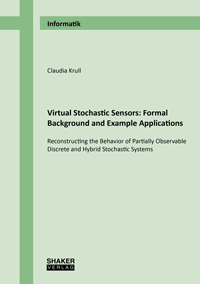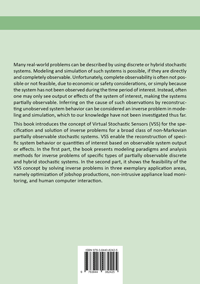
Shop : Details
Shop
Details
48,80 €ISBN 978-3-8440-8242-5Softcover202 pages47 figures299 g21 x 14,8 cmEnglishHabilitation
October 2021
Claudia Krull
Virtual Stochastic Sensors: Formal Background and Example Applications
Reconstructing the Behavior of Partially Observable Discrete and Hybrid Stochastic Systems
Many real-world problems can be described by using discrete or hybrid stochastic systems. Modeling and simulation of such systems is possible, if they are directly and completely observable. Unfortunately, complete observability is often not possible or not feasible, due to economic or safety considerations, or simply because the system has not been observed during the time period of interest. Instead, often one may only see output or effects of the system of interest, making the systems partially observable. Inferring on the cause of such observations by reconstructing unobserved system behavior can be considered an inverse problem in modeling and simulation, which to our knowledge have not been investigated thus far.
This book introduces the concept of Virtual Stochastic Sensors (VSS) for the specification and solution of inverse problems for a broad class of non-Markovian partially observable stochastic systems. VSS enable the reconstruction of specific system behavior or quantities of interest based on observable system output or effects. In the first part, the book presents modeling paradigms and analysis methods for inverse problems of specific types of partially observable discrete and hybrid stochastic systems. In the second part, it shows the feasibility of the VSS concept by solving inverse problems in three exemplary application areas, namely optimization of jobshop productions, non-intrusive appliance load monitoring, and human computer interaction.
This book introduces the concept of Virtual Stochastic Sensors (VSS) for the specification and solution of inverse problems for a broad class of non-Markovian partially observable stochastic systems. VSS enable the reconstruction of specific system behavior or quantities of interest based on observable system output or effects. In the first part, the book presents modeling paradigms and analysis methods for inverse problems of specific types of partially observable discrete and hybrid stochastic systems. In the second part, it shows the feasibility of the VSS concept by solving inverse problems in three exemplary application areas, namely optimization of jobshop productions, non-intrusive appliance load monitoring, and human computer interaction.
Keywords: discrete stochastic model; doubly stochastic process; behavior reconstruction; stochastic Petri-net; stochastic system; non-Markovian model
Available online documents for this title
DOI 10.2370/9783844082425
You need Adobe Reader, to view these files. Here you will find a little help and information for downloading the PDF files.
Please note that the online documents cannot be printed or edited.
Please also see further information at: Help and Information.
Please also see further information at: Help and Information.
| Document |  | Document | ||
| Type |  | |||
| Costs |  | 36,60 € | ||
| Action |  | Purchase in obligation and download the file | ||
| Document |  | Table of contents | ||
| Type |  | |||
| Costs |  | free | ||
| Action |  | Download the file | ||
User settings for registered online customers (online documents)
You can change your address details here and access documents you have already ordered.
User
Not logged in
Export of bibliographic data
Shaker Verlag GmbH
Am Langen Graben 15a
52353 Düren
Germany
Am Langen Graben 15a
52353 Düren
Germany
Mon. - Thurs. 8:00 a.m. to 4:00 p.m.
Fri. 8:00 a.m. to 3:00 p.m.
Fri. 8:00 a.m. to 3:00 p.m.
Contact us. We will be happy to help you.



